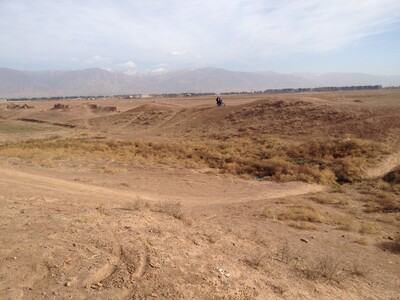
Nishapur نیشابور and The Palace of Happiness شادیاخ
The Palace of Happiness and “new Shapur” or Nishapur was founded in the third century and was a key city on the Silk Road, rivaling Damascus in size. It reached the height of its prosperity under the Samanids, in the tenth century. When the husband of Genghis Khan‘s daughter was killed there, in 1221, she ordered the slaughter of the 1.7 million inhabitants. The skulls of men, women, and children were piled in pyramids by the Mongols, and Shadiyakh was destroyed.
I walk along the ruined spine in the dust, following the narrow paths of the motorbike tracks, and feeling absurdly like Mary Poppins in my long black coat and scarf, clutching my heavy leather case. My driver Ali miserably follows me. He emits a cry of alarm when a small motorbike ridden by two boys makes for us, weaving their 125 through the humps and hollows of Shadiyakh. They stare as they pass, but I ignore them, kicking my way through the thorns and stepping over a busy line of black shiny ants carrying husks to and fro.
Reaching the tumulus, I like its formless generosity. Gaping holes have been opened in its sides, possibly in the hope of finding ancient treasures. The bricks of the palace walls are still evident, just as they are in the excavated area I’ve left behind me. Here they have eroded into soft humps. The boys have circled back, and now they join me on the tumulus, revving the bike to climb it and then weaving through the corridor to disappear from sight on the far side of the mound.
I turn as I hear another small motorbike speed over the line of humps, this one bound for somewhere further in the farmland. Now the boys appear above me on the flat top of the mound, causing Ali to shift about uncomfortably. It’s hard to say why, but the boys don’t worry me. One boy comes over to inspect me. I film him. I feel no threat from them at all, and I don’t think I need to acknowledge them. It’s clear that they belong on the mound, and they are part of this desolated landscape. I film a hole disappearing into the clay of the site. It’s so large that I could easily climb into it. Then I film the line of ants climbing, scaled, into a similar hole of their nests. I film dust, and lumps, and shadows. I keep asking Ali to move his shadow out of my line of view. The sun is very low on this midwinter afternoon, so our shadows are etiolated and hard to control. “Can I see what you’ve filmed?” asks Ali. “Not till it’s back in England and been processed in a lab,” I say. He doesn’t understand this, but I don’t explain further.


